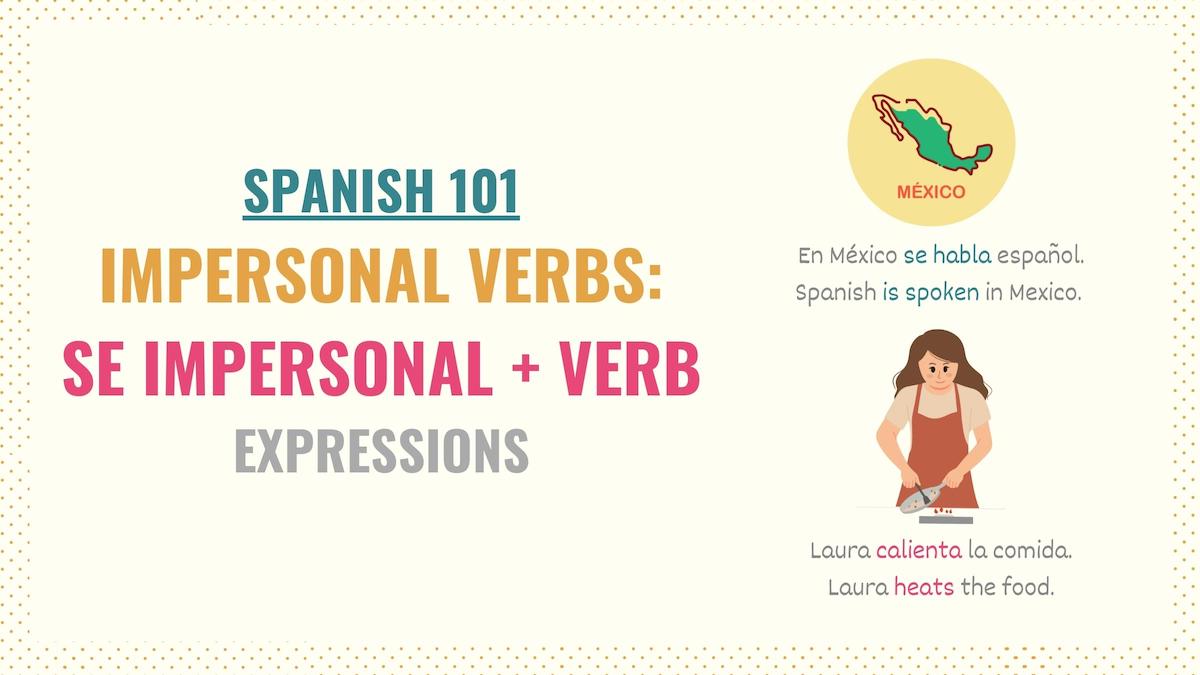In Spanish, impersonal verbs are often used in basic conversations, such as describing a place’s customs and expressing obligation, among other valuable applications. Since they can help you sound more natural here’s what you’ll find in this impersonal expressions Spanish guide:
- What Is an Impersonal Verb in Spanish?
- List of Spanish Impersonal Phrases
- Structures with impersonal se
- Key Points
- Additional Resources
- Downloadable PDF
I’ll include impersonal sentences and rules you need to follow to use these verbs correctly.
What Are Spanish Impersonal Verbs

As the name implies, Spanish impersonal verbs are a type of verb that have no subject (person or entity). In simple terms, these verbs convey that an action is not performed by a specific person or thing.
Check the difference between these Spanish sentences:
| Impersonal sentence | Sentence with a subject |
|---|---|
| Hoy hace mucho calor. Today is very hot. | Victoria hace la tarea. Victoria does her homework. |
| Es importante que me escuches. It’s important that you listen to me. | Su papá es doctor. His dad is a doctor. |
With the impersonal sentences (left), it’s clear that nobody is performing that action. There’s not a person or thing who is making the day hot. In these cases, the subject is not necessary to convey the message. However, with the examples on the right, we do have a clear subject (Victoria and dad).
In the sections below, you’ll learn more about using these verbs in Spanish.
Take Note: Do not confuse an impersonal verb with a sentence where the subject has been omitted –hace la comida (she prepares lunch), for example. In Spanish, the conjugation endings and context can be enough to know who is performing the action. As a result, we can leave the subject pronoun out.
How & When to Use an Impersonal Verb in Spanish?
In Spanish, verbs in the impersonal form must always use the third-person singular conjugation. Put another way, these verbs use the endings for él, ella, and usted.
The verb haber is the exception to this rule only when conjugating it to the present tense. In which case, you’ll have to use its irregular form hay.
Impersonal verbs in Spanish are often used to talk about the weather and natural phenomena, describe the existence of something, or refer to a place’s customs or behaviors.
Based on these uses, the most common Spanish impersonal verbs are:
- Amanecer: To dawn
- Anochecer: To get dark
- Haber: There is / There are
- Hacer: To make / To do
- Granizar: To hail
- Llover: To rain
- Ser: To be
Take Note: A Spanish verb in the past participle, gerund, or infinitive form is also considered to be impersonal. However, unlike the verbs you’re learning here, these conjugations cannot stand alone and have a subject pointed out by auxiliary verbs.
List of Common Spanish Impersonal Expressions
Now that you have learned some weather verbs and other verbs that can be used impersonally, you should check the following examples of impersonal expressions in Spanish:
- Es cierto que: It’s true that
- Es mediodía: It’s midday
- Es tarde: It’s late
- Hace calor: It’s hot
- Hace frío: It’s cold
- Hay: There is / There are
- Había: There was / There were
- Llovió mucho: It rained a lot
- No es importante: It’s not important
- Puede ser: It could be
Take Note: Many impersonal expressions are formed with ser + noun. Notice that most of these expressions are translated into English as “it’s…”.
Lo siento, es tarde y tenemos que irnos.
I’m sorry, it’s late, and we have to go.
En México siempre hace calor.
It’s always hot in Mexico.
¿Por qué hay tanta gente?
Why are there so many people?
Spanish impersonal expressions and the subjunctive
The Spanish subjunctive tense is triggered by many impersonal phrases formed with ser + adjective. Here are some of the most common phrases you must know:
- Es bueno que: It’s good that
- Es importante que: It’s important that
- Es necesario que: It’s necessary that
- Es posible que: It’s possible that
- Es una lástima que: It’s a shame that
- Está mal que: It’s wrong that
- Es recomendable que: It’s advisable that
- No es cierto que: It’s not true that
- No es seguro que: It’s not certain that
You can also use the affirmative phrases listed above in their negative form:
Chicos, es importante que hagan su tarea.
Guys, it’s important that you do your homework.
Es una lástima que no hayan podido venir.
It’s a shame that you guys couldn’t come.
No es necesario que escribas tu nombre.
It’s not necessary that you write your name.
Impersonal Se

In the sections above, you learned some specific verbs that can be used in impersonal form to talk about natural phenomena and obligations, among other things.
However, impersonal phrases can also be formed with the pronoun se and a verb in the third-person singular form. This is what is commonly known as se impersonal.
Se + [verb third person singular]
En Colombia se habla español.
Spanish is spoken in Colombia.
La carne se cocina así.
The meat is cooked this way.
En este restaurante se come muy bien.
In this restaurante, you eat very well.
Se prohíbe fumar en este lugar.
Smoking is not permitted in this place.
No se permite la entrada con alimentos.
Entry with food is not allowed.
Notice that impersonal se in Spanish can be used with any verb, but you must still use its singular conjugation. The purpose of se impersonal is to build sentences without a subject that allows you to talk about traditions, rules, or behaviors in a general way.
Take Note: In English, there’s no such thing as the pronoun se. As a result, when translating sentences with se impersonal into English, the translation will vary.
Key Points
Impersonal structures are a key to learn Spanish grammar and, most importantly, improve your conversations. Here are some important points you should never forget:
- Impersonal structures are sentences that have no subject.
- So, according to Spanish grammar rules, these verbs must only be conjugated in the third-person singular.
- In Spanish, there are two ways to form impersonal expressions:
- Using specific verbs (haber, hacer, ser, etc)
- Using se impersonal + any verb
- These structures are used to discuss the weather, obligations, and a group of people’s customs or behaviors.
Spanish Impersonal Verb-Related Resources
Here are some useful links you should check to take this topic to the next level. Since it’s such a basic word in daily conversations, you should learn how to use hay correctly.
Describing weather conditions is one of the contexts where you’ll use many impersonal verbs and expressions. So, make sure you know enough vocabulary to ask or explain the weather in Spanish.
On top of the applications you just learned, the pronoun se has other uses. All of them are equally important, so make sure you understand how to use this word. Finally, here are some conjugation guides that will help you use these verbs in different tenses:
Download the Impersonal Verbs & Expressions PDF Cheat Sheets
Impersonal expressions, se and verbs is a more advanced grammar topic for Spanish learners. To provide my readers and community with the best free resources available, I’ve made a PDF you can download containing all the cheat sheets for this guide. It includes the highlight notes, key points, when and how to use the verbs and expressions, along with a list of phrases you can start implementing into your conversations.



